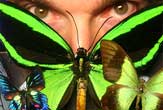
Science was way behind nature in developing LED light technology, a new study finds.
The beautifully colored wings of African swallowtail butterflies manipulate light using engineering tricks similar to those found in digital displays. The butterflies have black wings with bright patches of green and blue, which they use to communicate across long distances. Microscopic scales covering the wings absorb ultraviolet light and then re-emit it.
The re-emitted light interacts with fluorescent pigments found on the butterflies’ wings to produce the vibrant green-blue color.
Like LEDs
Researchers investigating how the scales work found that they have many similarities to digital devices known as light emitting diodes, also known as LEDs, which are found in everything from computer and television screens to traffic lights.
The first LEDs invented in the late 1960s weren’t very bright. They produced a lot of light but most of it tended to either become trapped inside the device or to spread sideways and become diluted.
In the early 1990s, engineers came up with ways to get around these problems. They outfitted LEDs with tiny mirrors that could reflect and channel the light and made microscopic holes in them to help the light escape.
Get the world’s most fascinating discoveries delivered straight to your inbox.
Behind the butterflies
While studying the wings of swallowtail butterflies, researchers discovered that there were a lot of similarities between the scale coverings and LEDs.
The scales that cover the butterflies’ wings contain tiny structures called “photonic crystals,” which act very much like the microholes found in LEDs.
“[The scales] prevent the fluorescent light from being trapped inside the scales and from being emitted sideways,” said Pete Vukusic of Exeter University, a researcher in the study.
The scales on the wing also have a specialized mirror underneath them, which act very much like the tiny mirrors found in LEDs.
The mirror reflects all the scattered fluorescent light it receives upward, giving the butterflies control over the direction in which in the light is emitted.
The study was reported in the Nov. 18 issue of the journal Science.


